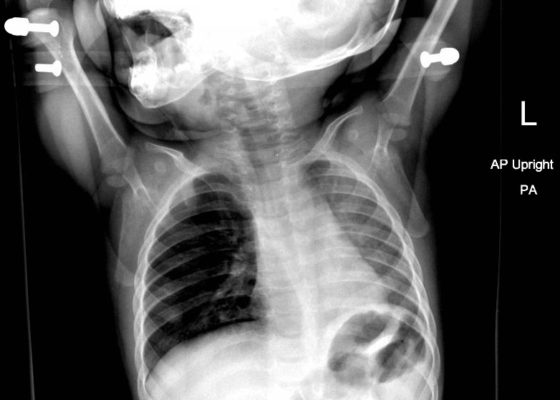Pediatrics
Low Cost Task Trainer for Neonatal Umbilical Catheterization
DOI: https://doi.org/10.21980/J8HW6GBy the end of this instructional session learners should: 1) Discuss the indications, contraindications, and complications associated with umbilical catheterization. 2) Competently perform umbilical catheterization on the task trainer. 3) Demonstrate proper securement of the catheter.
Pediatric Foreign Body Aspiration
DOI: https://doi.org/10.21980/J8B648Chest radiograph showed increased radiolucency (red arrow) and flattening of the diaphragm on the right side (blue arrow) consistent with hyperinflation of the right lung, as well as left mediastinal shift (green arrow), indicating obstruction.
Precipitous Birth
DOI: https://doi.org/10.21980/J8192RBy the end of this simulation session, the learner will be able to: 1) Recognize impending delivery, 2) identify abnormal maternal vital signs and potential associated pathologies (eg: hypertension in preeclampsia), 3) discuss the evaluation and management of postpartum bleeding, 4) discuss the principles of neonatal resuscitation, 5) appropriately disposition the patients, and 6) effectively communicate with team members and nursing staff during resuscitation of a critically ill patient.
Pediatric Toxic Shock Syndrome
DOI: https://doi.org/10.21980/J8WK8JBy the end of this simulation session, the learner will be able to: 1) Recognize toxic shock syndrome. 2) Review the importance of a thorough physical exam. 3) Discuss management of toxic shock syndrome, including supportive care and the difference in antibiotic choices for streptococcal and staphylococcal toxic shock syndrome. 4) Appropriately disposition a patient suffering from toxic shock syndrome. 5) Communicate effectively with team members and nursing staff during a resuscitation of a critically ill patient.
Pediatric Esophageal Foreign Body
DOI: https://doi.org/10.21980/J8GD1FA radiopaque foreign body was visualized in the proximal esophagus at the thoracic inlet on the chest and neck radiographs. The foreign body appeared to be metallic with visualized concentric rings consistent with a coin.
Pediatric Sepsis Case Scenario
DOI: https://doi.org/10.21980/J8MK5XPediatric sepsis is a low-frequency, high impact condition. Nurses and physicians do not see it often, but must recognize and treat children with sepsis efficiently when they present. This makes pediatric sepsis education particularly amenable to simulation scenarios.
A Toddler with Abdominal Pain and Emesis
DOI: https://doi.org/10.21980/J8XW2PIn the long axis video, the appendix appears as an enlarged, non-compressible, blind-ending tubular structure (white arrow) with distinct appendiceal wall layers and lack of peristalsis. In the short axis video, the appendix appears as a target sign (yellow arrow) between the abdominal and psoas muscles. The maximal outer diameter (MOD) measures 11.8mm and the appendix wall measures 0.17mm. There is trace adjacent free fluid and echogenic periappendiceal fat. Transverse axis video and image (red arrow) demonstrate that the appendix is not compressible. These findings are consistent with acute appendicitis.
Febrile Seizure Simulation
DOI: https://doi.org/10.21980/J81018At the end of this simulation session, the learner will be able to: 1) discuss the management of febrile seizures 2) discuss when placement of an advanced airway is indicated in the management of a febrile seizure 3) list the risk factors for febrile seizures 4) prepare a differential diagnosis for the causes of febrile seizures 5) educate family members on febrile seizures.




